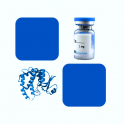
- Remove this product from my favorite's list.
- Add this product to my list of favorites.
Products
Newsletter
 |  |  |  |  |  |

Background
Insulin-like growth factor 2 (IGF-2) is also known as Somatomedin-A, IGF-II, PP9974, and is one of three protein hormones that share structural similarity to insulin. IGF-2 exerts its effects by binding to the IGF-1 receptor. IGF2 may also bind to the IGF-2 receptor (also called the cation-independent mannose 6-phosphate receptor), which acts as a signalling antagonist; that is, to prevent IGF2 responses. The major role of IGF2 is as a growth promoting hormone during gestation. In the process of Folliculogenesis, IGF2 is created by Theca cells to act in an autocrine manner on the theca cells themselves, and in a paracrine manner on Granulosa cells in the ovary. IGF2 promotes granulosa cell proliferation during the follicular phase of the menstrual cycle, acting alongside Follicle Stimulating Hormone (FSH). After ovulation has occurred, IGF-2 promotes progesterone secretion during the luteal phase of the menstrual cycle together with Luteinizing Hormone (LH). Thus, IGF2 acts as a Co-hormone together with both FSH and LH. IGF-2 may play a key role in memory and could potentially be used to treat Alzheimer's Disease. It is sometimes produced in excess in islet cell tumours, causing hypoglycemia. Doege-Potter syndrome is a paraneoplastic syndrome in which hypoglycemia is associated with the presence of one or more non-islet fibrous tumors in the pleural cavity. has been shown to interact with IGFBP3 and Transferrin.
Source
Recombinant Biotinylated Human IGF-II, Avitag,Fc Tag (IG2-H82F9) is expressed from human 293 cells (HEK293). It contains AA Ala 25 - Glu 91 (Accession # P01344-1).
Predicted N-terminus: Gly
Molecular Characterization
This protein carries an Avi tag (Avitag™) at the N-terminus, followed by a human IgG1 Fc tag
The protein has a calculated MW of 35.3 kDa. The protein migrates as 40 kDa under reducing (R) condition, and 66 kDa under non-reducing (NR) condition (SDS-PAGE) due to glycosylation.
Biotinylation
Biotinylation of this product is performed using Avitag™ technology. Briefly, the single lysine residue in the Avitag is enzymatically labeled with biotin.
Biotin:Protein Ratio
Passed as determined by the HABA assay / binding ELISA.
Endotoxin
Less than 1.0 EU per μg by the LAL method.
Purity
>95% as determined by SDS-PAGE.
Formulation
Lyophilized from 0.22 μm filtered solution in Tris with Glycine, Arginine and NaCl, pH7.5 with trehalose as protectant.
Reconstitution
Please see Certificate of Analysis for specific instructions.
For best performance, we strongly recommend you to follow the reconstitution protocol provided in the CoA.
Storage
For long term storage, the product should be stored at lyophilized state at -20°C or lower.
Please avoid repeated freeze-thaw cycles.
This product is stable after storage at:
-20°C to -70°C for 12 months in lyophilized state;
-70°C for 3 months under sterile conditions after reconstitution.
Bioactivity
Please refer to product data sheet.
(1) "Factors associated with disease control failure in acromegaly patients treated with pegvisomant: an ACROSTUDY analysis"
Giampietro, Chiloiro, Urbani et al
Endocr Connect (2024)
(2) "The conserved RNA-binding protein Imp is required for the specification and function of olfactory navigation circuitry in Drosophila"
Hamid, Gattuso, Caglar et al
Curr Biol (2023)
(3) "Extracellular α-synuclein impairs sphingosine 1-phosphate receptor type 3 (S1PR3)-regulated lysosomal delivery of cathepsin D in HeLa cells"
Nishida, Matovelo, Kajimoto et al
Genes Cells (2024)
Showing 1-3 of 14741 papers.
Follow us